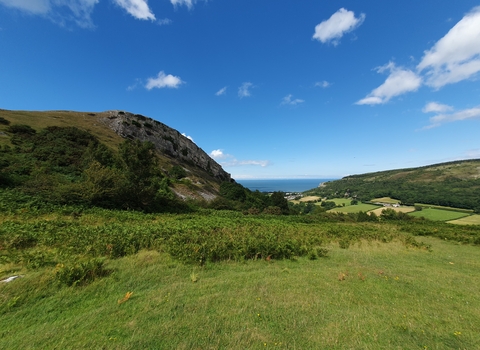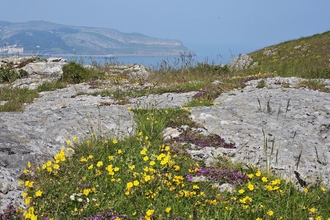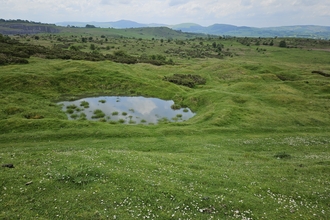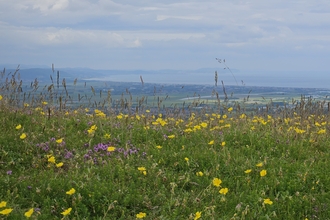Help shape your nature project
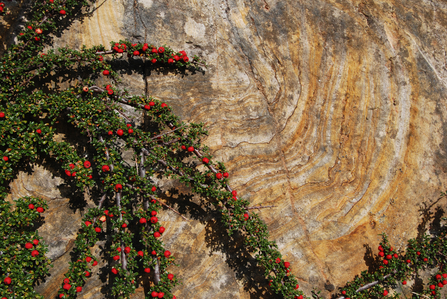
Cotoneaster © Lin Cummins
Join the Limestone Grassland Community Roots project and be part of protecting some of North Wales’ most special wild places near Llanddulas — including Craig y Forwyn, Pen y Corddyn Mawr, Pen y Corddyn Bach, and Mynydd Marian.
These limestone grasslands are home to rare wildflowers, butterflies, and birds, but are under threat from invasive species like cotoneaster and the loss of traditional land management. Without action, we risk losing the incredible biodiversity and beauty of these landscapes.
We’re working with local people to restore habitats, remove invasive species, and create opportunities for learning, volunteering, and community connection. Whether you live nearby, walk your dog here, or simply care about nature, you can help shape and support this exciting new project, by taking part in our survey.

Limestone grassland ©Philip Precey
Why do we want to protect limestone grasslands?
As the days get longer, limestone grasslands should be ablaze with colour. Bountiful swards of flowers include small scabious, kidney vetch, carline thistle, rock rose and salad burnet. Delicate bee and pyramidal orchids will be on display accompanied by thyme, stemless thistle and knap weed. An abundance of butterflies including marbled white, brown argus and silver studded blue, will visit for their rich source of nectar.
Unfortunately, this is not the case for many of our limestone grasslands. Flowers which would have once been in full bloom have been smothered and outcompeted by cotoneaster, dominating the large areas of once favorable grassland. Sadly, 90% of our semi natural grasslands have declined since the 20th century, remaining areas are now often small in size and highly fragmented, having devastating effects on our local wildlife. To help protect our cherished habitats, we must take action for nature.
We believe that limestone grasslands disappearing from our landscapes would be a huge loss, and getting people involved in conserving them locally can have real benefits – for individuals, communities as well as our wildlife!
What are we doing?
This project is funded by the Welsh Government's Landfill Disposal Tax Communities Scheme, administered by the WCVA. We're excited to continue the legacy of great work delivered by volunteers and partners involved in the Limestone Grassland Restoration project.
The initial phase of the project will focus on:
-
Learning from the community to help shape the project and its events
-
Consulting with local residents, schools, and community groups to reflect their values and aspirations
-
Tailoring activities to ensure the project is truly community-driven and aligned with local needs
The next phase of the project will focus on:
-
Delivering activities and events shaped by the community
-
Restoring limestone grasslands by removing invasive species such as cotoneaster
-
Supporting the regeneration of native wildlife by creating space for natural seed banks to grow
-
Raising awareness of the importance of limestone grasslands through guided walks and educational outreach
-
Providing citizen science opportunities for the community to actively participate in monitoring and conservation efforts
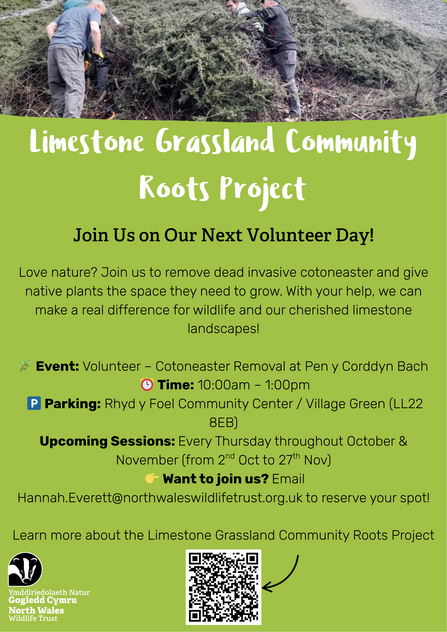
Questions or want to get involved? Contact us
Hannah Everett, Cotoneaster Project Manager
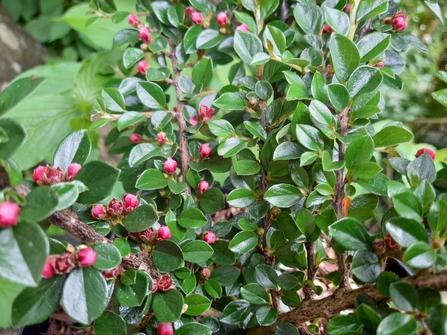
Identify the most dominant and invasive species of cotoneaster
Cotoneaster species are listed on the Schedule 9 to the Wildlife and Countryside Act 1981 England and Wales. Although still readily available to buy, it can be planted and contained in private gardens. However it is an offence to plant or otherwise cause these species to grow in the wild. GBNNSS
Entire leaved cotoneaster (C. integrifolius)
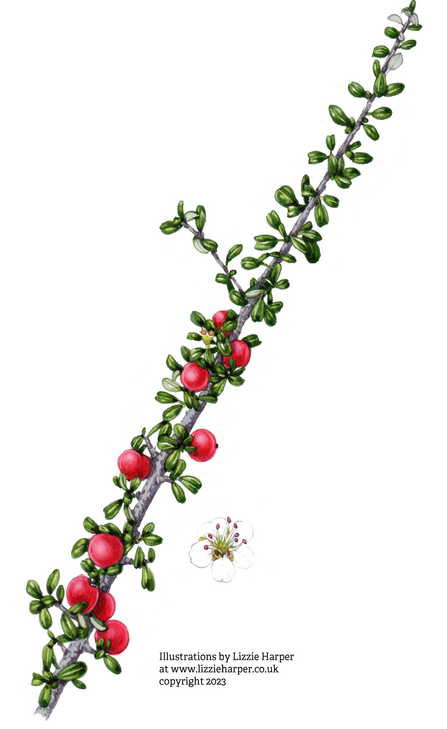
©Illustrations by Lizzie Harper at www.lizzieharper.co.uk copyright 2023 Entire leaved Cotoneaster (C. integrifolius)
- Evergreen low growing shrub
- Leaves: small elliptical, dark green and hairs underside
- Flowers: white, purple anthers
- Berries: late summer crimson colour, holds throughout winter
Himalayan cotoneaster (C. simonsii)
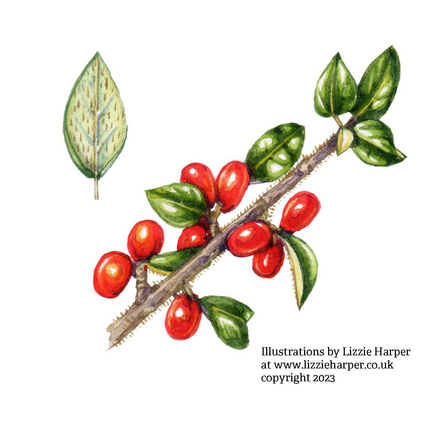
©Illustrations by Lizzie Harper at www.lizzieharper.co.uk copyright 2023 Himalayan cotoneaster (C. simonsii)
- Large hardy upright evergreen shrub
- Leaves: small none serrated, alternate along stem, glossy hairless upper and slight hairs on lower surface
- Flowers: pale pink, red patch centre of petal
- Berries: slightly larger, orange-red in clusters
Hollyberry cotoneaster (C. bullatus)
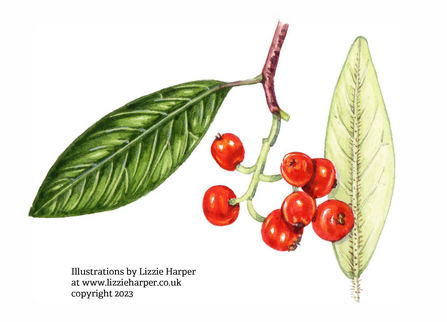
©Illustrations by Lizzie Harper at www.lizzieharper.co.uk copyright 2023 Hollyberry cotoneaster (C. bullatus)
- Much larger deciduous shrub up to 4 metres
- Leaves: matt green, oval and pointed, indented veins growing alternate on stem
- Flowers: pink, 5 petal, white anthers
- Berries: bright red, large slight square-shaped
Small leaved cotoneaster (C. microphyllus)
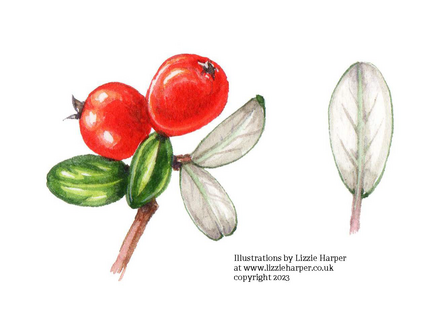
©Illustrations by Lizzie Harper at www.lizzieharper.co.uk copyright 2023 Small leaved cotoneaster (C. microphyllus)
- Evergreen low-lying shrub
- Leaves: glossy green top, grey/white underside, small (1cm length), elliptic
- Flowers: solitary white, 5 petals, dark violet anthers
- Berries: coral red and globular
Wall cotoneaster (C. horizontalis)

©Illustrations by Lizzie Harper at www.lizzieharper.co.uk copyright 2023 Wall cotoneaster (C. horizontalis)
- Deciduous low growing shrub: herringbone-shaped branches, stems woody dark brown, hard and knotty
- Leaves: small dark green upper, pointed and shiny on both sides, red in autumn
- Flowers: pink, 5 petal with white anthers
- Berries: orange-red

This project is funded by the Welsh Government's Landfill Disposal Tax Communities Scheme, administered by the WCVA

